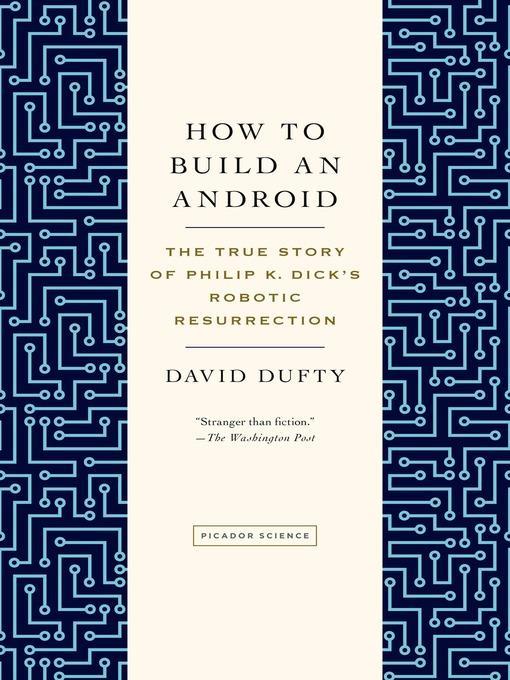
How to Build an Android
The True Story of Philip K. Dick's Robotic Resurrection
کتاب های مرتبط
- اطلاعات
- نقد و بررسی
- دیدگاه کاربران
نقد و بررسی

March 26, 2012
Dufty engagingly chronicles the efforts of a team of University of Memphis roboticists to build an android modeled on science fiction writer Philip K. Dick. The book shows how the researchers attempted, partially successfully, to build a machine that not only looked like the Do Androids Dream of Electric Sheep? author, but also imitated his speech patterns. Dufty, a postdoctoral researcher at the university when the team debuted “Phil,” lucidly explains the logistical hurdles facing the robotics team members as well as how they solved some significant problems; “Phil” sometimes babbled incessantly in response to questions when he was unveiled in 2005, spurring the team to build a kill switch. Dufty focuses on two main developers who created Phil—David Hanson, a Rhode Island School of Design graduate and founder of Hanson Robotics, who created Phil’s head only to later lose it on an airplane, and Andrew Olney, a computer programmer who was obsessed with science fiction books as a youngster. Dufty examines how their differing outlooks influenced the project: Olney wanted to build an android that could answer questions intelligently, while Hanson wanted to create a machine that would appear human. Dufty’s narrative is a fun read that captures the researchers’ excitement about creating Phil, but doesn’t quite address whether the initiative was worth the effort.

May 15, 2012
The story of the roboticists who created a fully functioning android replica of renowned writer Philip K. Dick. Dufty was a postdoctoral fellow at the University of Memphis when he was introduced to a group of doctorate students and researchers working on an unusual project in artificial intelligence and robotics: creating an android to look, sound and act exactly like Dick. Now a senior research officer at the Australian Bureau of Statistics, the author follows the story of the android's creation, from how it began as separate software and robotic projects, to its untimely finish when it was lost in transit by an airline, never to be seen again. Physically, the android had cameras and microphones for its eyes and ears, inside a molded skeleton covered with tiny gears (to emulate speech and facial expressions). Its skin was made of Frubber--a lightweight, pliant plastic--sculpted into the living image of the author. Inside the android's head was a powerful computer system that could process audio and visual input and then formulate spoken responses based on Dick's writing and interviews he gave throughout his life. Much of the book centers on the development of the android itself, a highly technical story that Dufty manages to make intriguing and accessible to less tech-savvy readers, but he often gets sidetracked by other ideas or stories. Some digressions are relevant and interesting--e.g., the section on the Turing test, which examines a machine's ability to exhibit intelligent behavior and addresses the question of whether the Philip K. Dick replica could actually think for itself. Other anecdotes, however--e.g., a tedious description of the difficulties the robotics team had renting a truck to move the android and its accouterments--slow the narrative momentum. A fascinating story unevenly told.
COPYRIGHT(2012) Kirkus Reviews, ALL RIGHTS RESERVED.

Starred review from June 15, 2012
In the early 2000s, an android replica of sf legend Philip K. Dick became a sensation in artificial intelligence circles. Its human face and exceptional programming, along with a database of Dick's writings and interviews, allowed people to converse with it. It made the rounds of conferences, attracting huge crowds, until December 2005 when its head was lost on an airline flight en route to a meeting at Google headquarters. The head has never been found. Dufty (senior research officer, Australian Bureau of Statistics), who worked on the project, tells the story of the conception, planning, and building of the android. An android of this complexity faced constant problems and technical difficulties, but the team met these challenges with creative thinking and novel approaches. Duffy here interviews many of the people involved in the project, adding depth to his own personal experience. VERDICT An enjoyable book that reads more like a memoir than a history; highly recommended to anyone with an interest in robotics or modern technology.--Betty Galbraith, Washington State Univ. Lib., Pullman
Copyright 2012 Library Journal, LLC Used with permission.

May 1, 2012
It's good that true story appears in this book's subtitle because it could easily pass, with very minor tweaks, for something produced by the prodigious imagination of late sf writer Philip K. Dick. In 2005, a roboticist forgot a piece of carry-on luggage when he got off a plane. The luggage and its contents, a full-size head of a robotic Philip K. Dick, vanished forever. Dufty, who was involved (in a sort of peripheral way) with the creation of the Dick android, takes the reader through the creation of the mechanical marvel, a process that included several technological breakthroughs, not to mention the delicate matter of obtaining permission from the author's heirs to use his likeness and his writings. It's a fascinating and mind-bending book, written for the general reader, although experts in the field of robotics will find it particularly stimulating, and fans of Dick's oeuvre will be captivated by the whole idea of turning the legendary storyteller into a mechanical man.(Reprinted with permission of Booklist, copyright 2012, American Library Association.)

























دیدگاه کاربران